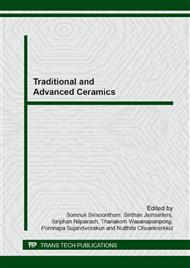p.159
p.164
p.170
p.175
p.181
p.187
p.193
p.200
p.206
Effect of Sintering Conditions on Mechanical and Optical Properties of 3Y-TZP Dental Ceramic
Abstract:
The use of zirconia dental ceramics has grown in recent years due to improvements in esthetics and biocompatibility. Zirconia is used in dental applications for its high strength and fracture toughness. In this research, the influence of sintering conditions on the strength and optical properties of zirconia was investigated. Spray dried granules of 3Y-TZP zirconia were die pressed into disc-shaped samples and cold isostatic pressed at 250 MPa. Sintering was conducted using either one step sintering at 1500 oC or two-step sintering, with pre-sintering at 1200 oC and final sintering at 1500 oC. Heating rates of 2 and 10 oC/min were used. The biaxial flexural strength, fracture toughness, density, microstructural characteristics and optical properties of the sintered samples were determined. It was found that the sintering conditions did appear to influence the mechanical and optical properties. The sintering conditions had no significant effect on the density. It was concluded that for the sintering conditions examined, the two-step sintering with a heating rate of 2 oC/min produced the best average mechanical and optical properties of 3Y-TZP zirconia.
Info:
Periodical:
Pages:
181-186
Citation:
Online since:
April 2014
Keywords:
Price:
Сopyright:
© 2014 Trans Tech Publications Ltd. All Rights Reserved
Share:
Citation:


